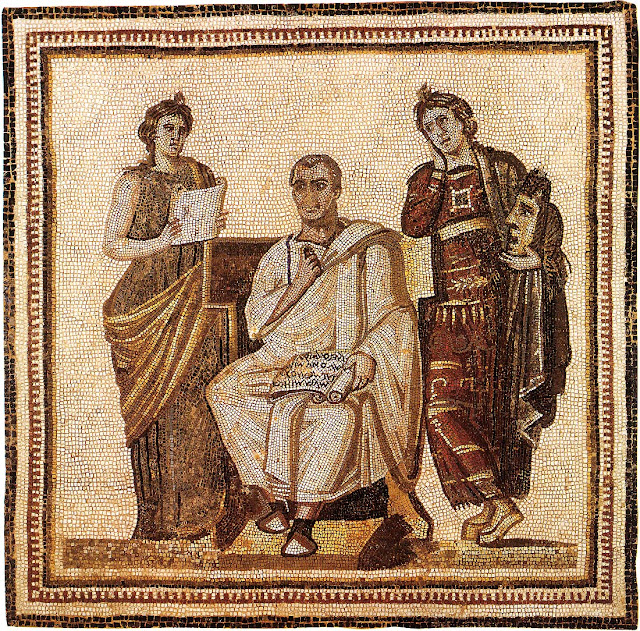 |
| The Papyrus Plant along the Nile River |
Pliny the Elder (ca. 77 CE) gave a fascinating account of the ancient manufacturing processes for papyrus paper which was used in making bookrolls.
"Paper of all kinds is ' woven ' on a board moistened with water from the Nile, muddy liquid supplying the effect of glue. First an upright layer is smeared on to the table, using the full length of papyrus available after the trimmings have been cut off at both ends, and afterwards cross strips complete the lattice-work. The next step is to press it in presses, and the sheets are dried in the sun and then joined together, the next strip used always diminishing in quality down to the worst of all. There are never more than twenty sheets to a roll.” (Nat. 13.80)Pliny continued and described the various sizes and qualities of papyrus sheets in use;
“There were also eighteen-inch sheets called 'macrocola,' (macrocolis) but examination detected a defect in them, as tearing off a single strip damaged several pages. On this account Claudius paper has come to be preferred to all other kinds, although the Augustus kind still holds the field for correspondence; but Livia paper, having no quality of a first-class kind, but being entirely second class, has retained its position.” (Nat. 13.80)Although Pliny indicated that the "macrocola" paper had fallen out of use in his day (ca. 77 CE) Cicero (ca. 44 BCE) made explicit reference to this size of papyrus in a letter to his friend Atticus.
It appears that Cicero was referring to the same type of papyrus paper described by the Elder Pliny more than one hundred years later. This paper must have been expensive, so it is surprising that Cicero instructed Atticus to copy his work while the work was still being revised and edited. About a year earlier (ca. 45 BCE) Cicero had written Atticus about some of his books that were to be sent on to Varro (the dedicatee of the work).". . . I am sending you the same composition [On Old Age] more carefully revised, indeed the original copy, with plenty of additions between the lines and corrections. Have it copied on large paper (macrocollum) and read it privately to your guests; but, if you love me, do it when they are in a good temper and have had a good dinner, for I don't want them to vent on me the anger they feel towards you." (Att. XVI.3)
Menander reading a Bookroll, Pompeii
"But what on earth is the reason why you are so frightened at my bidding you send the books to Varro on your own responsibility? Even now, if you have any doubts, let me know. Nothing could be more finished than they are. . . . However, I don't despair of winning Varro's approval; and, as I have gone to the expense of a large paper copy (macrocolla), I should like to stick to my plan."Once again Cicero made referrence to these deluxe sized bookrolls, the "macrocolla," and he seems to have mentioned that this format was a big expense compared to other paper sizes and book formats (see Austin, pg. 14-15).
(Att. XIII.25)
Cicero's comments help us understand the drastically divergent approach that Christians had in regards to their sacred writings. Most early Christian (papyrus) fragments of the writings that later formed the New Testament contrast drastically from the expensive and ornate rolls that Cicero described (for more on these differences, see From Scroll to Codex: Early Christian Book Technology).
____________
Bibliography.
Austin, Jacqueline. Cicero's Books and the "Giessener Verres." Unpublished paper, 2008.
Cicero. Letters to Atticus. Translated by E. O. Winstedt. Vol. 3. Loeb Classical Library. Cambridge: Harvard University Press, 1961.
Pliny. Natural History. Translated by H. Rackham. Vol. 4. Loeb Classical Library. Cambridge: Harvard University Press, 1960.




